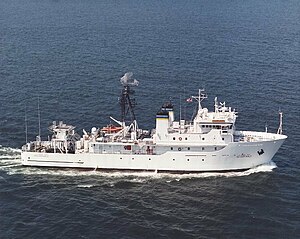NOAAS McArthur II (R 330)

USNS Indomitable (T-AGOS-7) departing Seattle, Washington.
|
|
| History | |
|---|---|
|
|
|
| Name: | USNS Indomitable (T-AGOS-7) |
| Namesake: | : Incapable of being subdued, overcome, or vanquished |
| Operator: | Military Sealift Command |
| Builder: | Tacoma Boatbuilding Company, Tacoma, Washington |
| Laid down: | 26 January 1985 |
| Launched: | 16 July 1985 |
| Acquired: | 26 November 1985 (delivered to U.S. Navy) |
| In service: | 1 December 1985 |
| Out of service: | 2 December 2002 |
| Fate: | Transferred to National Oceanic and Atmospheric Administration 9 December 2002 |
|
|
|
| Name: | NOAAS McArthur II (R 330) |
| Namesake: | William Pope McArthur (1814-1850), a United States Coast Survey officer who pioneered hydrographic survey work on the United States West Coast, and NOAAS McArthur (S 330), the NOAA survey ship McArthur II replaced. |
| Builder: | Tacoma Boatbuilding Company, Tacoma, Washington |
| Acquired: | 9 December 2002 (from U.S. Navy) |
| Commissioned: | 20 May 2003 |
| Decommissioned: | 18 June 2014 |
| Homeport: | Seattle, Washington |
| Identification: |
|
| Nickname(s): | "Big Mac" |
| Status: | Inactive in NOAA Pacific Fleet |
| General characteristics (as U.S. Navy ocean surveillance ship) | |
| Class and type: | Stalwart-class ocean surveillance ship |
| Displacement: |
|
| Length: | 224 ft (68 m) |
| Beam: | 43 ft (13 m) |
| Draft: | 15 ft (4.6 m) |
| Installed power: | 1,600 horsepower (2.1 megawatts) |
| Propulsion: | Diesel-electric: Two General Electric 800-horsepower (1.1-megawatt) diesel engines, two shafts |
| Speed: | 11 knots |
| Complement: | 33 (15 U.S. Navy personnel, 18 civilians) |
| General characteristics (as NOAA research ship) | |
| Type: | ex-U.S. Navy Stalwart-class oceanographic research ship |
| Tonnage: | |
| Displacement: |
|
| Length: | 224 ft (68 m) |
| Beam: | 43 ft (13 m) |
| Draft: | 15 ft (4.6 m) |
| Installed power: | Two General Electric diesel engines (2 × 800 hp (600 kW)) |
| Propulsion: |
|
| Speed: | 10.5 to 11 knots (19.4 to 20.4 km/h; 12.1 to 12.7 mph) (sustained) |
| Range: | 8,000 nautical miles (15,000 km; 9,200 mi) |
| Endurance: | 30 or 45 days |
| Boats & landing craft carried: |
One 24-foot (7.3 m) Zodiac rigid-hulled inflatable boat (RHIB); one 21-foot (6.4 m) Zodiac RHIB |
| Complement: | Either 22 (5 officers, 4 licensed engineers, and 13 other crew) or 24 (4 officers, 3 licensed engineers, and 17 other crew) plus up to either 15 scientists on domestic voyages or up to 14 scientists plus a Public Health Service during international voyages; or 21 (5 officers, 3 licensed engineers, and 13 other crew, plus 10 to 15 scientists |
| Sensors and processing systems: |
One Furuno X-band radar, one Furuno S-band radar, both for navigation and collision avoidance; two depth sounders; a Furino Automated Identification System; several Global Positioning System receivers; Speery MK227 gyrocompass |
| Notes: | 600 kilowatts electrical power; 250-kilowatt emergency generator |
USNS Indomitable (T-AGOS-7) was a United States Navy Stalwart class ocean surveillance ship in service from 1985 to 2002. From 2003 until 18 June 2014, she was in commission in the National Oceanic and Atmospheric Administration (NOAA) as the oceanographic research ship NOAAS McArthur II (R 330).
Indomitable was laid down by the Tacoma Boatbuilding Company at Tacoma, Washington on 26 January 1985 and launched on 16 July 1985. She was delivered to the U.S. Navy on 26 November 1985 and placed in non-commissioned service in the U.S. Navy's Military Sealift Command on 1 December 1985 as USNS Indomitable (T-AGOS-7), a United States Naval Ship with a mixed crew of U.S. Navy personnel and civilian merchant mariners.
Stalwart-class ships were designed to collect underwater acoustical data in support of Cold War anti-submarine warfare operations. Accordingly, Indomitable employed Surveillance Towed Array Sensor System (SURTASS) equipment on Cold War underwater surveillance duties during the final years of the Cold War.
After the Cold War ended with the collapse of the Soviet Union in late December 1991, requirements for such surveillance declined. In 1993, Indomitable's SURTASS gear was removed, and she received an AN/SPS-49 radar for use in counternarcotics surveillance. In her new role for counter narcotics patrol she deployed for two missions per year starting September 1993. As well as her civilian crew, she embarked 18 Navy personal to operate her sensors and coordinate with authorities. For her first five missions she averaged 300 days underway per year operating in the Caribbean Sea and Panama Canal area.
...
Wikipedia
